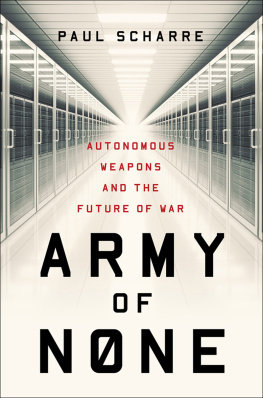Paul Scharre - Army of None: Autonomous Weapons and the Future of War
Here you can read online Paul Scharre - Army of None: Autonomous Weapons and the Future of War full text of the book (entire story) in english for free. Download pdf and epub, get meaning, cover and reviews about this ebook. year: 2018, publisher: W. W. Norton & Co., genre: Romance novel. Description of the work, (preface) as well as reviews are available. Best literature library LitArk.com created for fans of good reading and offers a wide selection of genres:
Romance novel
Science fiction
Adventure
Detective
Science
History
Home and family
Prose
Art
Politics
Computer
Non-fiction
Religion
Business
Children
Humor
Choose a favorite category and find really read worthwhile books. Enjoy immersion in the world of imagination, feel the emotions of the characters or learn something new for yourself, make an fascinating discovery.
- Book:Army of None: Autonomous Weapons and the Future of War
- Author:
- Publisher:W. W. Norton & Co.
- Genre:
- Year:2018
- Rating:3 / 5
- Favourites:Add to favourites
- Your mark:
Army of None: Autonomous Weapons and the Future of War: summary, description and annotation
We offer to read an annotation, description, summary or preface (depends on what the author of the book "Army of None: Autonomous Weapons and the Future of War" wrote himself). If you haven't found the necessary information about the book — write in the comments, we will try to find it.
A Pentagon defense expert and former U.S. Army Ranger explores what it would mean to give machines authority over the ultimate decision of life or death.
What happens when a Predator drone has as much autonomy as a Google car? Or when a weapon that can hunt its own targets is hacked? Although it sounds like science fiction, the technology already exists to create weapons that can attack targets without human input. Paul Scharre, a leading expert in emerging weapons technologies, draws on deep research and firsthand experience to explore how these next-generation weapons are changing warfare.
Scharres far-ranging investigation examines the emergence of autonomous weapons, the movement to ban them, and the legal and ethical issues surrounding their use. He spotlights artificial intelligence in military technology, spanning decades of innovation from German noise-seeking Wren torpedoes in World War IIantecedents of todays homing missilesto autonomous cyber weapons, submarine-hunting robot ships, and robot tank armies. Through interviews with defense experts, ethicists, psychologists, and activists, Scharre surveys what challenges might face centaur warfighters on future battlefields, which will combine human and machine cognition. Weve made tremendous technological progress in the past few decades, but we have also glimpsed the terrifying mishaps that can result from complex automated systemssuch as when advanced F-22 fighter jets experienced a computer meltdown the first time they flew over the International Date Line.
At least thirty countries already have defensive autonomous weapons that operate under human supervision. Around the globe, militaries are racing to build robotic weapons with increasing autonomy. The ethical questions within this book grow more pressing each day. To what extent should such technologies be advanced? And if responsible democracies ban them, would that stop rogue regimes from taking advantage? At the forefront of a game-changing debate, Army of None engages military history, global policy, and cutting-edge science to argue that we must embrace technology where it can make war more precise and humane, but without surrendering human judgment. When the choice is life or death, there is no replacement for the human heart.
Paul Scharre: author's other books
Who wrote Army of None: Autonomous Weapons and the Future of War? Find out the surname, the name of the author of the book and a list of all author's works by series.












